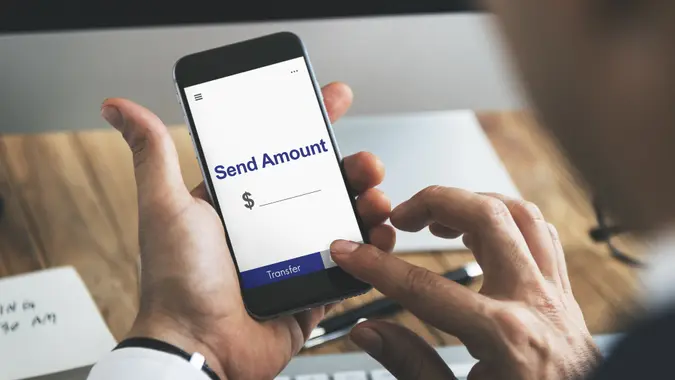5 Reasons Why Reviewing Your Bank’s Fees and Charges Can Grow Your Savings

Commitment to Our Readers
GOBankingRates' editorial team is committed to bringing you unbiased reviews and information. We use data-driven methodologies to evaluate financial products and services - our reviews and ratings are not influenced by advertisers. You can read more about our editorial guidelines and our products and services review methodology.

20 Years
Helping You Live Richer

Reviewed
by Experts

Trusted by
Millions of Readers
Bank fees can act like a drain on your savings. Without a review of your bank fees from time to time, it’s easy to accidentally let bank fees stop your savings from growing as fast as they could. The good news is that it’s possible to keep an eye on your bank fees and keep your savings growing.
Here are some of the top reasons why reviewing bank account’s fees and charges matters.
Unknown Fees Might Be Hiding in Your Statements
Most, if not all, bank accounts come with some embedded fees. Of course, some bank accounts come with fewer fees than others. But even if you believe your account includes limited fees, it’s always a good idea to double-check your bank statements to uncover any unknown fees.
Some common fees to look for include account maintenance fees, excessive transaction fees, wire transfer fees and physical check fees. Any of these fees can pull money out of your account, which directly puts a drain on your savings goals.
It’s a good idea to comb through your statements regularly to keep an eye on the fees charged by your bank. If you discover that you are facing more fees than you previously thought, you have a few options. You could close the account and move your funds to a different bank account with fewer fees.
Alternatively, you could take steps to prevent being charged that fee in the future. For example, if you uncover an out-of-network ATM fee, you can switch to using in-network ATMs in order to avoid the fee.
Account Maintenance Fees Add Up
Many bank accounts come with monthly maintenance fees. Although these fees grant you access to the account, monthly fees can put downward pressure on your savings goals, even if the monthly fee seems relatively small. For example, let’s say you have a checking account with a $5 monthly fee, which adds up to a cost of $60 annually, which means you have $60 less to put toward your savings goals for the year.
Some accounts offer to waive the monthly fee after meeting certain requirements, like a minimum balance threshold or using your debit card regularly. But if you have an account with a waivable monthly fee, it’s possible you’ll run into a month where you don’t meet the requirements. After checking your statement and noticing this cost, consider calling the bank to have them waive the fee for a single month. If they honor your request, you can stick those savings back in your pocket.
I’ve experienced this exact situation before. My checking account has a waivable monthly fee. But during one month, I didn’t meet the minimum balance requirement to qualify for a fee waiver. Since I had the account for several years without running into this issue, I called up my bank and asked for them to waive the monthly fee this one time. To my surprise, they agreed. I was able to save the $15 instead of forking it over to a bank, every little bit helps me make progress toward my savings goals.
If you want to switch to a checking account without any fees, scope out the top options for free checking accounts today.
ATM Reimbursements May Help
Some banks give you fee-free ATM access through a network of ATMs. Other banks offer ATM reimbursements when you incur a fee at an out-of-network ATM. Still others offer customers no break on ATM fees at all.
If you work with a bank that offers ATM fee reimbursements, it’s a good idea to stay on top of that reimbursement. Although the reimbursement should hit your account automatically, sometimes banks make mistakes. When you qualify for an ATM fee reimbursement, don’t hesitate to ask your bank about the reimbursement timeline. If your question prompts the reimbursement to go through, it’s well worth the minimal effort of checking your bank statements.
Overdrafts Might Remind You To Stay On Budget
When you overdraft your account, you’ll likely face an overdraft fee. Since this fee is typically around $35, according to Bank of America, it’s generally enough to make a difference to your budget — especially if you incur multiple overdraft fees. Taking the time to find out how much your bank will charge you after an overdraft might give you an incentive to stay on budget. After all, this fee can add up quickly.
Prevent Unnecessary Fees
When you sign up for a bank account of any kind, reading through the fees can help you avoid actions that will unknowingly push you into paying a fee.
For example, let’s say you opened a certificate of deposit (CD). Most CDs come with early withdrawal penalties. But the size of the fee varies based on the financial institution. If you know about the early withdrawal penalty before you withdraw funds early, you can avoid paying the fee by simply waiting to access the funds until your CD matures.
In another situation, you might want to transfer funds to another party. If you choose a wire transfer, the fee might be between $20 to $40. But if you opt for a peer-to-peer transaction, like Zelle, you could avoid the fee. Taking the time to understand your fee-free transfer methods can lead to savings that grow your overall net worth.
Ultimately, reviewing your bank’s fees and charges is important. Without this information on hand, it’s easy to get accidentally charged when you complete a banking task.
 Written by
Written by  Edited by
Edited by 
























